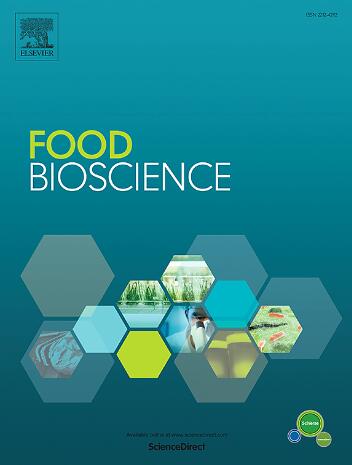Improving phenyllactic acid production of Gluconacetobacter tumulisoli FBFS 97 using a strong promoter, Pkan
IF 5.9
1区 农林科学
Q1 FOOD SCIENCE & TECHNOLOGY
引用次数: 0
Abstract
Phenyllactic acid (PLA) is a broad-spectrum antimicrobial substance with broad application prospects in the food industry. In our previous research, we isolated and screened a strain of acetic acid bacteria (AAB) from vinegar mash, Gluconacetobacter tumulisoli FBFS 97, which is the first reported AAB strain with the PLA production capacity. In current study, in order to increase the PLA production of the FBFS 97 strain, a strong promoter, Pkan (promoter of kanamycin resistance gene), suitable for the FBFS 97 strain, was screened using enhanced green fluorescent protein (EGFP) as a reporter. Then five related genes with PLA biosynthesis in the FBFS 97 strain, including the chorismate synthase gene aroc, the prephenate dehydratase gene pheA, the glucose dehydrogenase gene gdh, the formate dehydrogenase gene fdh and the glycerate dehydrogenase gene gldh were overexpressed using the Pkan promoter, respectively. The results revealed that except the gldh overexpression strain, PLA production of other mutants were improved to 125.9 %, 140.2 %, 130 % and 113 % comparing to that (56.85 mg/L) of the FBFS 97 strain, respectively. This study not only lays the foundation for constructing the high-producing PLA engineering strain using the FBFS 97, but also provides a novel insight for better understanding the PLA biosynthesis pathway of microorganisms.

使用强启动子Pkan改善葡醋杆菌坟坟FBFS 97的苯乳酸生成
苯乳酸(PLA)是一种广谱抗菌物质,在食品工业中具有广阔的应用前景。在前期的研究中,我们从醋醪中分离并筛选了一株醋酸菌(glucconacetobacter isoli FBFS 97),这是首次报道的具有PLA生产能力的AAB菌株。本研究以增强型绿色荧光蛋白(EGFP)为报告基因,筛选适合于FBFS 97菌株的强启动子Pkan(卡那霉素耐药基因启动子),以提高菌株PLA的产量。然后,利用Pkan启动子,对FBFS 97菌株中与聚乳酸生物合成相关的5个基因(choris酸合成酶基因aroc、预苯酸脱氢酶基因pheA、葡萄糖脱氢酶基因gdh、甲酸脱氢酶基因fdh和甘油脱氢酶基因gldh)进行过表达。结果表明,除gldh过表达菌株外,其他突变体的PLA产量分别比FBFS 97菌株(56.85 mg/L)提高了125.9%、140.2%、130%和113%。本研究不仅为利用FBFS 97构建高产PLA工程菌株奠定了基础,而且为更好地了解微生物的PLA生物合成途径提供了新的视角。
本文章由计算机程序翻译,如有差异,请以英文原文为准。
求助全文
约1分钟内获得全文
求助全文
来源期刊

Food Bioscience
Biochemistry, Genetics and Molecular Biology-Biochemistry
CiteScore
6.40
自引率
5.80%
发文量
671
审稿时长
27 days
期刊介绍:
Food Bioscience is a peer-reviewed journal that aims to provide a forum for recent developments in the field of bio-related food research. The journal focuses on both fundamental and applied research worldwide, with special attention to ethnic and cultural aspects of food bioresearch.
 求助内容:
求助内容: 应助结果提醒方式:
应助结果提醒方式:


